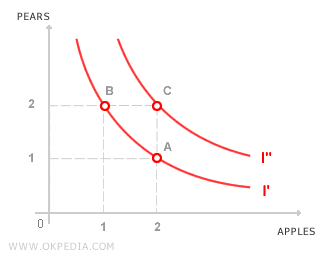Ordinal Utility
Ordinal utility is a concept in which bundles of goods are ranked according to preference, without assigning them any absolute numerical value. With ordinal utility, economists abandon the attempt to measure utility (cardinal utility). What matters is the relative ranking of choices, not their measured intensity. As a result, it’s not possible to add up individual utilities in a meaningful way. However, it is still possible to compare the utility of different consumption bundles. For example, a consumer may prefer bundle A over bundle B, without needing to quantify how much more satisfying A is.
A≻B
Ordinal utility doesn't capture the degree to which one bundle is preferred over another. Still, if a consumer prefers bundle A to bundle B, they will consistently choose A over B, regardless of how much greater the satisfaction may be. This approach allows neoclassical economists to build a theory of consumer preferences without relying on cardinal utility or the need for objectively measurable satisfaction - thus avoiding many of the theoretical criticisms aimed at cardinal utility. The concept of ordinal utility is rooted in the recognition that utility is inherently subjective, personal, and not measurable in absolute terms. It laid the foundation for microeconomic tools such as indifference curves, where consumer choice is driven not by measurable differences between curves, but purely by the order of preferences.
 Indifference Curves. Indifference curves represent combinations of two goods that yield the same level of utility on a Cartesian plane. For instance, a person might derive the same satisfaction from consuming 2 apples and 1 pear (choice A) as from consuming 1 apple and 2 pears (choice B). Both combinations (A and B) lie on the same indifference curve, labeled I', and are equally preferred by the consumer.
Indifference Curves. Indifference curves represent combinations of two goods that yield the same level of utility on a Cartesian plane. For instance, a person might derive the same satisfaction from consuming 2 apples and 1 pear (choice A) as from consuming 1 apple and 2 pears (choice B). Both combinations (A and B) lie on the same indifference curve, labeled I', and are equally preferred by the consumer.

Curves that lie farther from the origin represent higher levels of utility, as they allow for more of at least one good without reducing the amount of the other (e.g., choice C). Conversely, curves closer to the origin reflect lower utility levels. Crucially, with indifference curves, utility is no longer measured - it's simply compared. This comparative framework enables neoclassical economists to build a theory of consumption based on ordinal utility, freeing the analysis from the constraints and controversies surrounding the measurability of cardinal utility.
